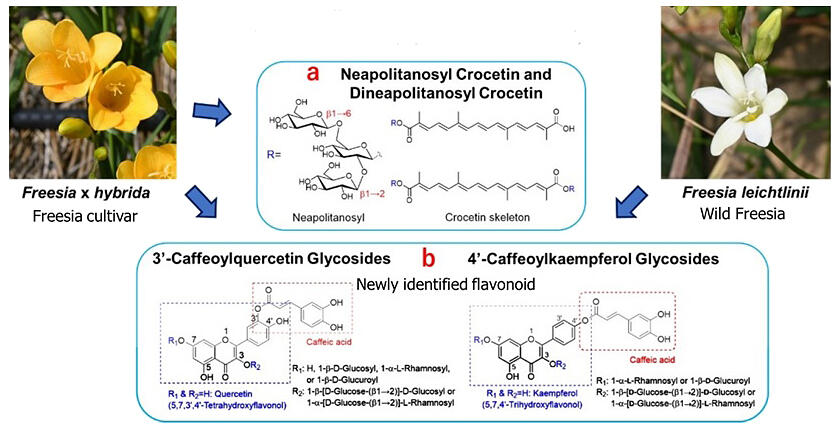Freesia (Freesia x hybrida), which blooms in spring, is one of the most popular flowers in Japan. The flowers open halfway, sheath by sheath, in sequence from the bottom. Because of its elegant appearance and excellent fragrance, it is popular in the form of cut flowers in the market. In the language of flowers, it means "affection," "friendship," and "gratitude." It has long been popular as a plant of the family Iridaceae with various flower colors such as yellow, white, pink, blue, purple, and red. Among these flower colors, yellow is the most popular, accounting for 80% of the Japanese market share. Ishikawa Prefecture promotes freesia production, and the cultivar "Airy" was developed at the Agricultural Experiment Station of the Ishikawa Agriculture and Forestry Research Center.
A research group including Professor Kazutoshi Shindo and members of his laboratory of the Department of Food and Nutrition at Japan Women's University and Guest Professor Norihiko Misawa (currently a professor of the Department of Nutrition at Hokuriku Gakuin University), Associate Professor Miho Takemura, and Associate Professor Yasuki Higashimura at Ishikawa Prefectural University, in collaboration with Project Academic Specialist Kazuo Furihata at the University of Tokyo and the Ishikawa Agriculture and Forestry Research Center, has discovered that the petals of yellow and white flowers of the popular ornamental plant freesia contain novel caffeoyl-flavonol glycosides (caffeoylquercetin glycosides, caffeoylkaempferol glycosides), which are colorless, water-soluble polyphenols with excellent antioxidant activity. Novel and rare natural compounds, including the yellow pigments (crocetin glycosides) in the yellow freesia flowers identified in their previous study, are expected to be developed into functional food and other materials. The results were published in Antioxidants.

Provided by Japan Women's University
The research group has previously shown that the yellow components in the yellow flowers of freesia are unique water-soluble carotenoids (crocetin glycosides), similar to the red pigment (crocin) found in saffron. This study found that water-soluble polyphenols with strong antioxidant activity were contained in the water-soluble and methanol-soluble fractions of yellow and white flowers. They purified and structurally analyzed these antioxidants.
The results showed that the water-soluble polyphenols were novel caffeoyl-flavonol glycosides: 3'-caffeoylquercetin glycosides and 4'-caffeoylkaempferol glycosides. Both aglycones have a skeleton consisting of caffeic acid, which directly forms an ester bond with quercetin or kaempferol. Compounds with such a skeleton were found for the first time in organisms. Quercetin glycosides, which do not contain the caffeic acid unit in the molecules, are found relatively widely in higher plants. They are used as antioxidant functional foods for the prevention of lifestyle-related diseases such as liver disorders and diabetes, reduction of body fat, and improvement of cognitive functions.
Some of the compounds isolated and identified in this study showed higher levels of in vitro antioxidant activity (lipid peroxidation inhibition and radical scavenging) than these compounds. Since both quercetin and caffeic acid have a catechol structure considered to have strong antiradical activity, the high radical scavenging activity of their ester derivative, 3'-caffeoylquercetin, is an expected finding. Furthermore, these compounds acquire water solubility by being coupled with three or two molecules of carbohydrates (hexoses) to one molecule of caffeic acid quercetin ester derivative, which is fat-soluble. In particular, those containing glucuronic acid as a sugar unit have high water solubility. Functional substances with high water solubility are expected to be useful in various applications because they are easy to process and use.
Freesia flowers are listed as edible in many parts of the world except Japan. Thus, the novel caffeoyl-flavonol glycosides discovered in this study are expected to have the potential for development as functional foods and pharmaceutical materials. In terms of the physiology of freesia per se, the compounds identified in this study impart the ability to resist photooxidation and continue to bloom for a long time to the yellow- and white-flower freesia plants. Moreover, it is conceivable that these compounds can serve as repellents against herbivorous insects, as they are expected to produce a bitter, pungent taste.
Journal Information
Publication: Antioxidants
Title: 3'-Caffeoylquercetin Glycosides and 4'-Caffeoylkaempferol Glycosides--Novel Antioxidant Flavonoids Discovered in the Freesia Yellow Flowers
DOI: 10.3390/antiox14020158
This article has been translated by JST with permission from The Science News Ltd. (https://sci-news.co.jp/). Unauthorized reproduction of the article and photographs is prohibited.




